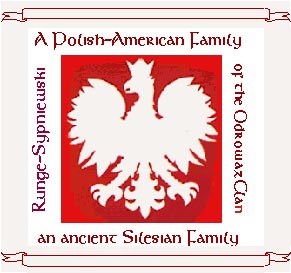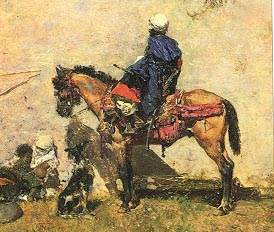

Polish Horses
Written and researched by Margaret Odrowaz-Sypniewska, B.F.A.

The history of Eastern European horses begun some 4,000 years ago in the Asian steppes. The Magyars of Hungary were their direct descendants and they used Asian Wild Horses. In fact, history tells us that Hungary fell under Turkish rule for 150 years, after the battle of Mohács, in 1526. As one might guess Hungarian stud horses were influenced by Turkish stock.
The first stud farm in Hungary was founded on an island in the Danube River, in the 9th century. Arpád, the great-grandfather of Stephen I, King of Hungary (997-1038) was a tribal chief who began to breed horses.
In 1785 the stud farm called Mezóhegyes (after their stud of the same name) was begun by Joseph II (1741-1790), upon the advise of Joseph Csekoniks. They developed the Nonies, the Furioso, and the Gidran Arabians. These horses were classed as Anglo-Arabians.
The Bábolna stud farm was then begun by Czekoniks. The farm was named after the 700 year old estate of Babunapuszta. This estate was purchased, by the government from the Szapary family in 1789. In 1816, Arabian horses were studs at Bábolna and the Shagya line was brought from Syria in 1833 and agains in 1850.
THE HORSE CAVALRY:
Cavalry was first developed by Charles Martel and his Frankish knights. While the Mongols developed the Hungarian Hussars. The name hazar meant "20th" and they were raised by Mattias Corvinus, King of Hungary (15th c.). The 20th referred to the one man in twenty (20) that was required to serve in the military.
Like the Mongols, the early hussars were very mobile and used the first "Blitzkrieg-like" (lightning strike) technique perfected by the Germans in World War Two (WWII). This tactic was fast and furious and difficult to counterattack. In early times it was called "coup d' huzzard," by the French. Hussars rode with their knees bent in short stirrups, with the trunk of their body inclined forward (see "The Polish Rider" above). Later, in the 19th century, this techniques was revived by Captain Federico Caprilli (1868-1907). Caprillo taught at the Italian cavalry schools of Tor di Quinto and Pinerolo, as their chief instructor. This "Il Sistema" is still used today for jumping competitions worldwide.
POLAND:
In 1817, Janow Podlaski, was Poland's main stud. In 1914, the Russians took the stock from the Janow Podlaski farm. By 1919, they restarted the farm to brewd purebred Arabians. They bought mares from Radautz (Austro-Hungarian studs) and English Anglo-Arabians. These horses were famous all over Europe. Then, in 1939, the Germans again nearly destroyed the line. By 1950, the Half-Arabian breed was back at Janow, and by 1960, the purebreds were again established. Both Anglo-Arabians and Purebreeds are bred in Poland today.
Walewice bred Anglo-Arabians. The Liski Stud (of 1947) came from East Prussia, and Walewice specialized in old Trakehnen bloodlines. The Trakehnen were the mounts of Prussian armies.
The Polish horse called "Wielkopolski" was an important warmblood and its bloodlines were related to the Trakehner. The Wielkopolski came from Poznan and Mazury. They were bred at thirteen (13) Polish state stud farms as well as at private farms. The Trakehner originated in the 13th century in East Prussia. The Poles had a tradition much like the Hungarians. They favored Arabians and Arabian-like horses for their light cavalry. The Wielkopolski, though not an Arabian, is known for its good blood and strong constitution. It is considered one of the best, although unknown outside of Poland. It was bred in central and western Poland, and originated in Poznan at Posadowo, Racot, and Gogolewo stud farms, as agricultural horses. The Masuren was another stud farm in Masury district, and horses were bred in Liski at Starogod, Kwidzyn, and Gnieszno. The Wielopolski derives from the Poznan and Masuren warmblooded breeds (both have Arabian connections). The original Wielkopolski, however, is now officially extinct. The Wielkopolski we see today has been re-bred.

The Poznan was bred at the stud farms of Pasadowo, Racet, and Gogolewo. The were well established in the nineteenth (19th) century. The Poznan's base was provided by the hardy Konik pony, which is descended from the Tarpon (wild horse). The Poznan had Arabian and Thoroughbred blood, some Hanoverian, and some East Prussian Trakehner. It was used as an agricultural horse and for riding.
The Mazuran horse was bred in the Masury district, chiefly at Liski (home of the State studs). The Mazuran was in every way a Trakehner. The Wielkopolski stood 66 inches high, and it is found in all solid colors. The Wielkopolski is an excellent jumper with speed and stamina enough to be useful as a light harness horse.
The Hungarian Mezohegyes housed over 12,000 horses, at its peak. Mezohegyes raised the Shagya Arabian. Mezohegyes' Furioso sired more than ninety-five (95) stallions, many were imperial studs. North Star was the grandson of Touchstone who won the 1834 St Lege, and the 1836 and 1837 Ascot Gold Cup.
The Golden Age of horse breeding in Hungary lasted from 1870-1914. Murokozis were raised on the Murokozi stud farm, on the river Mura in southern Hungary. 20% of all these Hungarian horses were 64 inches tall. The Murokozi were also bred in Poland as light draught or farm horses.
The Asian Wild Horse, from which most of these horses sprang, were also named Przewalski's Horse. Nicholai Mikhailovitch Przewalski was a Colonel in the Russian Imperial Army. This breed was named after him, since he is reputed to have found this breed in 1879 on the Tachin Schah near the Gobi Desert. This area was the home of Genghis Khan and the Mongol hordes. Kirghiz hunters nearly ate this horse to extinction. They used hunting techniques similar to those used by Plains Indians, when hunting bison. The herds were driven off cliffs and plunged to their death below.
In 1889, four of these horses were brought to the estate of Friedrich von Falz-Fein of Askania Nova in the Ukraine. Within a year, seventeen colts and fifteen fillies were captured. They were fifty-two (52) inches in heighth, aggressive, and fierce. Commonly they were sand-dun colored with black legs. Its manes were stiff and grew upright to eight inches in length.
The Tarpan, like the Asian Wild Horse/Przewalski were almost extinct by the late 18th century.
The Tarpan were related to the Tibetan ponies called the Spiti and Bhutan. Tarpans ranged from the Carpathian Mountains to Turkestan. The Konik and Hacul are related to Tarpans (thought to have been used in the eastern Mediterranean for pulling chariots). In turn, the Tarpan are thought to be related to the Caspian stock of Iran. The modern Tarpan re-evolved from the Konik and Hucal stock. The Order of the Teutonic Knights begin horses breeding in the 13th century. The used the Schweiken pony, a descendant of the Konik (which descended from the Tarpon). By 1731, Friedrich Wilhelm I of Prussia, father of Frederick the Great, founded the Royal Trakehner stud. By 1913, 84% of all Trakehner mares were bred to Thoroughbred stallions. The greatest Thoroughbred was the English stud, Perfectionist, son of Persimmon (owned by the Prince of Wales, who later became King Edward VII (1901-1910) of England. Persimmon won the Epsom Derby and St. Leger in 1896.
The modern Tarpan is 52 inches high and they are mouse or brown dun colored with faint eel stripes and zebra marks on their legs. Their coats turn white in the winter. Many Tarpans are currently on reserves in Poland.
THE ARABIAN:

El Kelbi, an Arab historian, wrote the first account of the Arabian in 786, but its pedigree began in 3000 B.C.:

Arabian studs of the 18th and 19th century were at:
RELATED LINKS:
Polish Horses|Polski Zwiazek Jezdziecki|Polish Arabian Horses|Polish Arabian Breeders Society (Korona)|Polish Horses on the Interent|Gate of Dreams Arabians
SOURCES:
Edwards, Elwyn Hartley. The Encyclopedia of the Horse. New York: DK Publishing, Inc., 1994.
Kidd, Jane (editor). International Encyclopedia of Horses and Ponies. New York: Howell Book House, 1995.